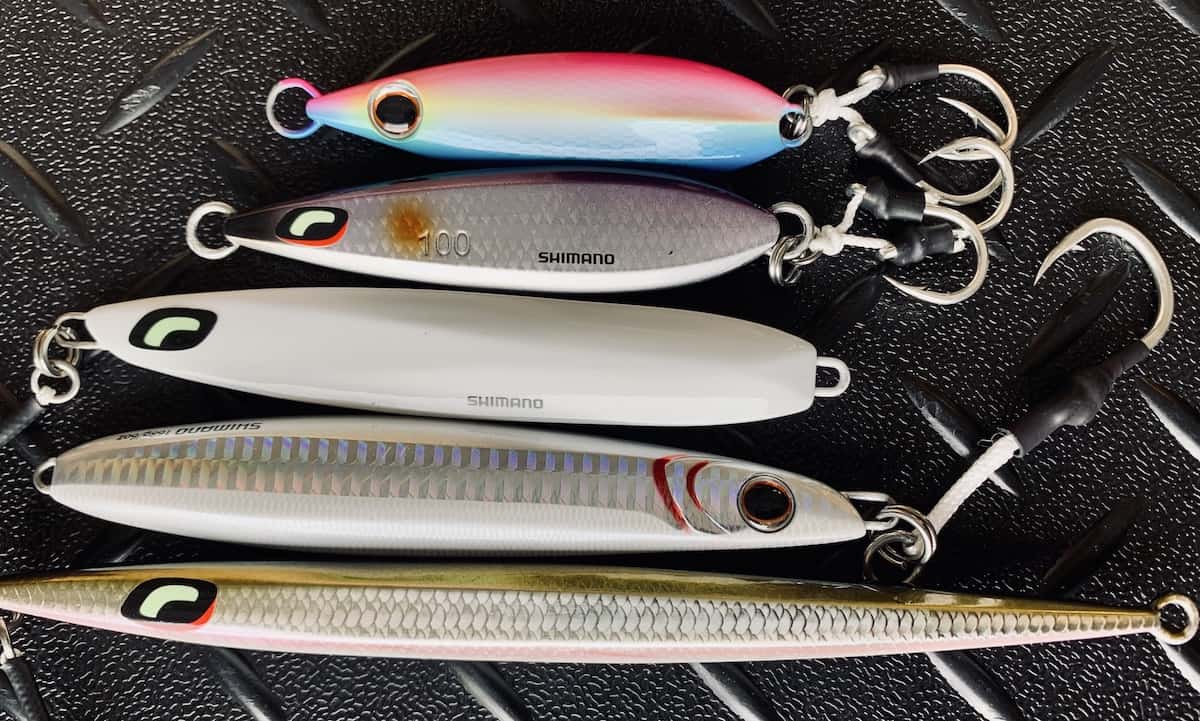What Is a Butterfly Jig?
A butterfly jig, also known as flutter jig, is a weighted jig that flutters when it falls to the bottom. Saltwater butterfly jigs are best used in deep offshore waters for species such as grouper, snapper, tuna, and nearly any other fish as the lures can be used all up and down the water column. The original style of butterfly jig is shaped to be flat on one side and a “V” shape on the other side. This shape causes the lure to orient itself with the flat side facing up to the surface and the “V” side facing down. The “V” shape causes the lure to move back and forth as it sinks.
The original butterfly is a slow jig, meaning it's meant to be fished with a slow jig technique. When the slow jigging technique is used, the jig falls to the bottom slowly because its fluttering on the way down. The jig is then jerked or reeled up, and allowed to fall again. The lure is most likely to get bit on the fall, so the best results occur when you can maximize how much time the lure is allowed to fall.
As the technique has expanded, more lure designs with different actions came to market. For example, some lures are short and wide, some are long and thin, some are tapered and some are rear weighted. If the weight is center-balanced, the jig will stay horizontal in the water as it falls and will move back and forth evenly. The flash on the lure will reflect and catch the eye of a fish as it moves back and forth in the water. This imitates a healthy baitfish. If the jig is balanced more towards the rear, it will have a more diagonal position in the water as it falls to mimic an injured baitfish. Some additional designs even spiral on the way down.
These jigs vary in size and can get pretty heavy to reach the bottom in deeper waters. You’ll most likely be targeting large grouper or snapper or tuna with these lures and so the hooks need to be large and the lure needs to be durable. I’d recommend looking for a lure that has through-wire construction, which is similar to the concept of rebar reinforced concrete. The through wire helps the jig withstand bites from some of the biggest fish by connecting the line tie eyelet with the hook eyelets with one through wire. All of the Shimano Butterfly jigs have through-wire construction.
As far as size goes, a good rule of thumb is to use 100 grams for every 100 feet of water depth. You’ll also need to make sure that your rod can handle the size of your lure. Before buying a jigging rod, consider the depth of waters you’ll most often fish, and choose a rod power that can handle the lures you’ll need. Although 100 grams for every 100 ft of water is a good rule of thumb, you may need to increase the size on days when the current is especially strong to make sure the lure can do a nearly vertical fall.
Choosing a Butterfly Jigging Rod & Reel
When choosing a rod, the lure size is important to influence the power you choose. For example, if you look at the Shimano Game Type J jigging rod, the medium power is rated for a 330 gram lure, the medium heavy power is rated for a max 400 gram lure, and a heavy power is rated for a max lure size of 500 grams. As long as travel and portability isn’t a primary concern, a single piece rod is a better choice to give you better sensitivity when jigging. You’ll want to be able to feel a bite and set the hook. The handles on slow pitch vertical jigging rods are typically longer to work with an underarm position. If you watch the YouTube videos of people doing vertical jigging, once they set the hook and are fighting the fish, they’ll often have the rod under their armpit to give them the best leverage for the fight. Anglers must also consider the pros and cons of spinning versus conventional tackle for vertical jigging. Since the lure is working on the fall, conventional reels are much preferred. The angler can put the reel in freespool and thumb the line on the spool to adjust the speed at which the lure falls. You can try several different fall speeds by varying the pressure you put on the spool. This isn’t possible with spinning tackle unless you want to hold the line above the reel. You can also catch large fish with butterfly jigging, and if you need to set the rod on the gunwale of the boat to help get leverage during the fight, a casting rod is best since the guides and line are on the top of the rod. Imagine putting a spinning rod on the gunwale of the boat. You’d be pinching the line against the rod, which definitely won’t help you land a fish. For specific rod and reel product recommendations, and a more detailed discussion on the subject, see our article here.
Rigging for Butterfly Jigs
Slow pitch vertical jigging with butterfly jigs is a pretty recent technique in fishing. As a result, there are only a few companies making these jigs, and only a few companies making spare assist hooks already rigged. This technique originated in Japan, and Shimano was the first company to market these types of lures in the US. This is a unique fishing technique which seems to attract a convenience bite from large fish, rather than relying on a feeding strike.
The hooks on the jigs are also an important feature and depend somewhat on your location. You’ll notice that a lot of them have two hooks on the top eyelet to increase the hook up rate. The dual hooks are often facing towards the center of the lure to avoid snags on the bottom. Trebles are generally avoided if you plan on reaching the bottom to help avoid snags on weeds or structure. They’re usually rigged with cord, but wire may be necessary if you encounter toothy fish. Before heading out for a day of slow jig fishing, I’d recommend being prepared by prepping some spare hooks, including some rigged with wire. Generally the hooks should be fall to about the center of the lure. Owner makes some sturdy stinger hooks worth checking out.
Now that we’ve talked about the general idea behind butterfly jigging, let’s look at each lure in Shimano’s Butterfly Jig collection:
1. Shimano Butterfly Monarch
Size & Color
The butterfly monarch jig is a sinking style jig that comes in sizes 90 grams (4 ¼ inches in length) through 160 grams (5 ¼ inches in length). It comes in a variety of colors which include green mackeral, chartreuse white, candy iwash, blue sardine, blue pink, and blue glow.
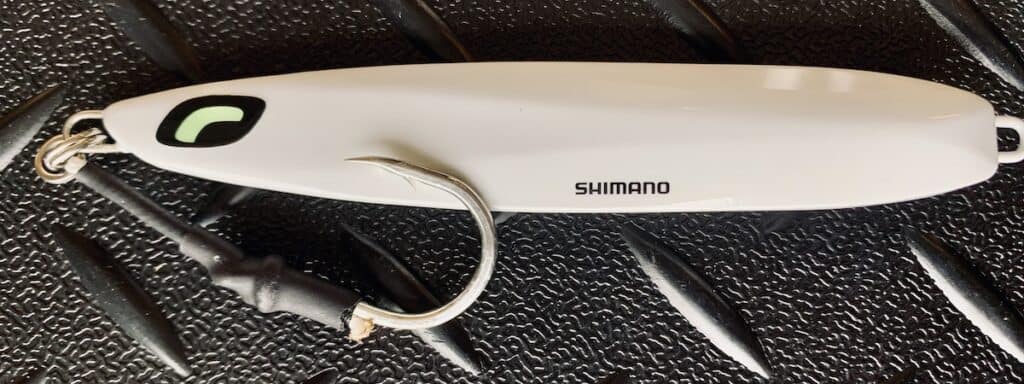
How to Work it
The lure is best fished by letting it fall, during which will stay horizontal for a moment and then spiral down. Then the angler can jerk the jig up and it’ll spiral going up as well. The spiral motion helps the holographic coloring shine and attract fish in some of the deepest waters. Depending on the size you choose, these jigs range from about $12 to $15 a piece.
How to Rig It
To rig this jig up, you’ll need split rings, solid rings, and assist hooks. I’d recommend at least 2 hooks for the top eyelet, and I generally do two more on the bottom eyelet as well. You can opt to keep it simple and use a single hook up top, but I notice my hookup ratios are better when I have two. The top hooks are most likely to hook the fish in the mouth, and the bottom hooks will assist by hooking the fish elsewhere in the face. When targeting big game fish, the extra hooks are critical to make sure you don’t lose your fish if something happens to the mouth hook.
The two hooks should hit about midway down the lure, and should face inward towards each other when this hook is used with a slow jig technique, and should face outward from each other when using a fast jig technique. Be sure to leave some space between the top and bottom hooks to make sure they don’t tangle. You’ll attach the jig to your leader line at the solid ring, in between the two hooks.
Anglers new to slow jigging will often ask if a swivel is necessary. I’d recommend using a swivel on any lure with a twisting action. This lure spirals down, which can cause line twist, so rigging with a swivel attached to the solid ring, and attaching your leader line to the swivel, is a good idea.
2. Butterfly Flat-Side
Size & Color
This lure is available in sizes from 112 grams to 325 grams. The price ranges from $15 to $25 depending on your chosen size and color. The lure is available in Black/Silver, Blue Sardine, Green/Silver, and White/Silver. I recommend keeping a variety of colors on hand so you can be ready to match the color of nearby baitfish.
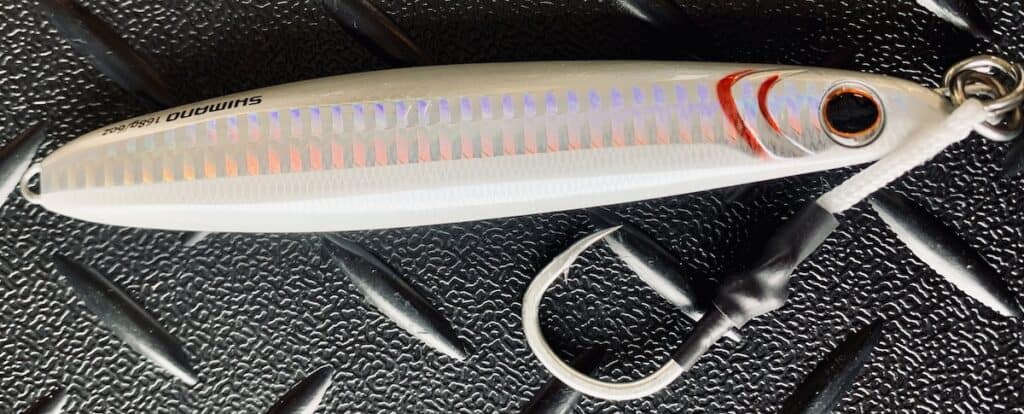
How to Work It
This lure is most effective when using a yo-yo jigging technique. Yo-yo jigging is when you put the reel in freespool and allow the lure to hit the bottom, then fast jig it halfway up the water column, and let it freespool again back down. This method repeated over and over will almost always get you a bite if there are fish nearby. The boat is usually drifting and the lure is allowed to hang at an angle with the current on the way down. This lure is weighted near the rear which causes it to wobble on the way down in an asymmetrical way to mimic an injured baitfish.
How to Rig It
This jig is rigged the same way as the Butterfly monarch, which one to two hooks up top attached via a split ring and solid ring. The split ring should be the largest ring out of the eyelet, split ring, and solid ring. Additional hooks can be added to the bottom eyelet for more hookup possibilities. Since this jig falls all the way to the bottom, its key to avoid a treble hook on the backside of the lure so you don’t constantly snag on structure.
3. Butterfly Flat-Fall
Size & Color
This lure is available in some of the smallest sizes, starting at 80 grams and goes up to 350 grams. It is a very popular lure by Shimano and is sold in a variety of colors, including black anchovy, blue sardine, chartreuse white, phantom squid, pink blue, sand eel, green silver, purple silver, super glow, and zebra glow. The glow colors are particularly effective when night fishing or when fishing at deep, dark depths.
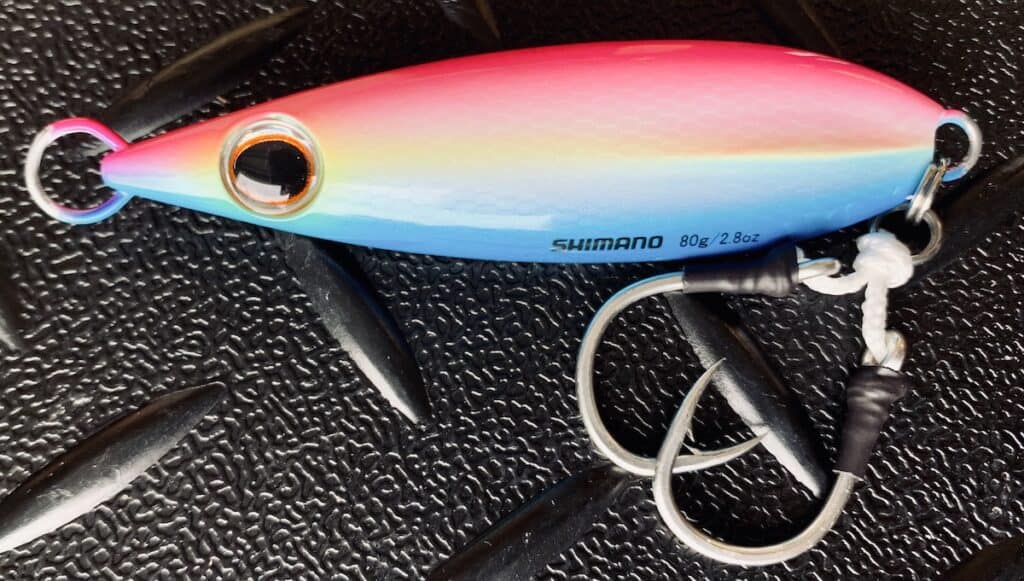
How to Work It
The Butterfly Flat Fall lure is center balanced, which means it will flutter back and forth evenly and horizontally on the fall. As the name implies, a flat fall jig is a jig that falls to the bottom horizontally. This mimics a healthy baitfish. It is intended to stay near the middle of the water column by freespooling to let the jig fall, jerking it up, freespooling again. The lure is most likely to be bit while its falling and fluttering horizontally, so the technique that allows it to stay falling as much as possible, is the best technique.
How to Rig It
This lure is a shorter lure, so I’d recommend using a shorter cord to attach your assist hooks. Connect the assist hook cord to a solid ring, connect the solid ring to the split ring, and connect your split ring to the hook eyelet on the lure. When tying your leader to the solid ring, you can skip the barrel swivel since the lure will wobble, and not twist.
4. Butterfly Wing-Fall
Size & Color
This lure comes in size 80 grams to 250 grams and artistic holographic colors. The colors include anchovy, blue sardine, blue glow, blue pink, chartreuse white, and pink silver. These colors provide plenty of flash to also attract fish via light reflection. The eyes on this lure are 3D which make them appear very realistic. The Wing-Fall runs between $12 (80 gram size) and $20 (250 gram size).
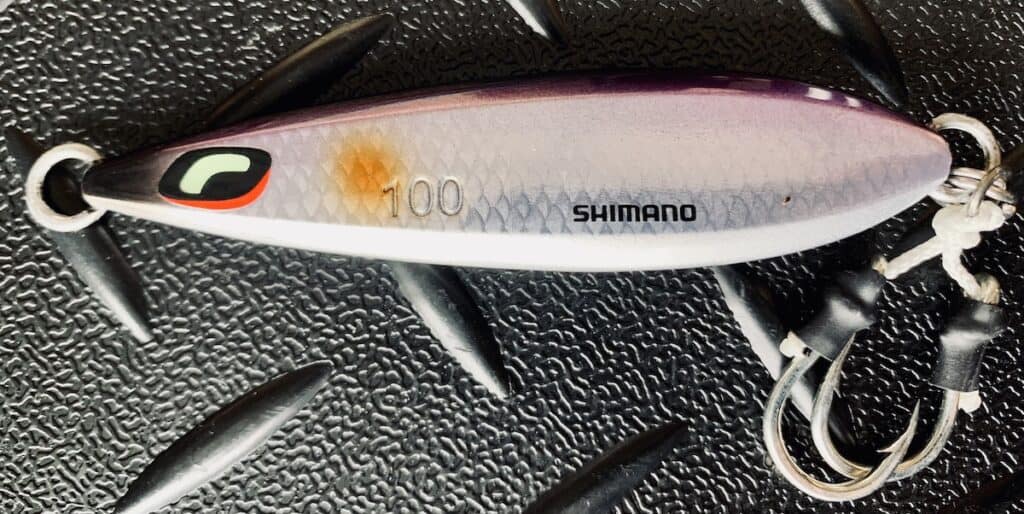
How to Work It
This lure has a variety of actions. It can fall with a wide roll, or a backslide, or a cradle swing. The erratic action simulates an abnormal, or injured, baitfish which is seen as easy pretty for game fish. You can work this jig with a slow jig technique by allowing it to fall slowly, or you can work it with a rapid retrieve for speed jigging. The lure is effective with both techniques, which gives the angler the advantage of varying the presentation without having to deal with switching lures out.
How to Rig it
I’d recommend rigging this lure the same way as the others, which two hooks up top and two hooks on the bottom and connecting it to the hook eyelets via split rings and solid rings. A barrel swivel would be a nice addition on this lure due to the variety of actions it’ll demonstrate. If you start encountering toothy fish, you may want to rig your hooks with wire.
5. Butterfly Shimmerfall
Size & Color
This lure is one of the larger butterfly lures by Shimano as it starts at a 100 gram size. There aren’t nearly as many size options as the Butterfly Flat Fall, but it does go up to a beefy 210 gram size. The colors include blue pink, blue sardine, chartreuse white, pink glow, sand eel, and squid. The lure varies in price from $12 to $18 from Tackle Direct.
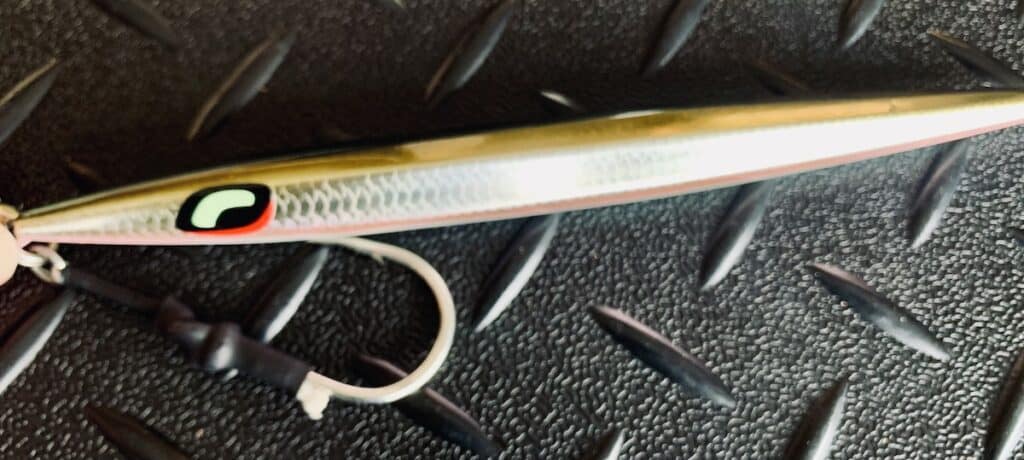
How to Work It
To round out Shimano’s butterfly jig collection, the Shimmerfall is a fast sinking stick lure that can sink quickly, even in aggressive currents. It's one of the easiest jigs to work as you can let it fall using almost any thumb pressure on the spool and reel it up quickly, or twitch it up, or even yo yo the lure. The action is enticing, as well as the flast from the colors.
How to Rig It
These lures have plenty of length to more easily rig up several hooks. Two hooks up top and two hooks on the bottom is a great place to start. Since this is a slender lure, I’d recommend choosing a hook size where the hook is wider than the body of the lure. This will help ensure that the hook grabs the mouth of the fish as soon as the lure is bit.
To most effectively use the butterfly jigging system from Shimano, you’ll need to pair these lures with the appropriate rod and reel. Read here for rod and reel recommendations. If you want to learn about other types of saltwater lures, read our Top Saltwater Topwater Lures article and our article Best Tuna Lures for Trolling Jigging and Casting. Tight lines, y'all!
Recent Posts
Fat Cow Jig Strips: The Ultimate Bucktail Jig Upgrade for Surf Fishing
As discussed in my previous article, "Surf Fishing with Bucktail Jigs: Ultimate Guide for Beach Anglers," bucktail jigs are a staple in any surf angler's tackle box, offering a versatile way to catch...
In my previous article, "Surf Fishing with Bucktail Jigs: Ultimate Guide for Beach Anglers," I introduced you to the bucktail jig and discussed how versatile of a lure it is for catching a wide range...

